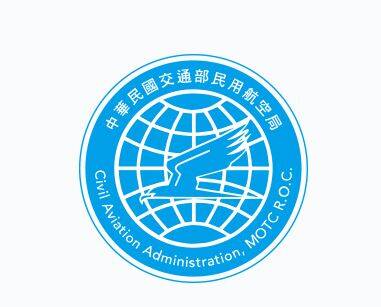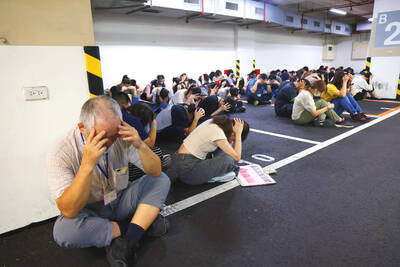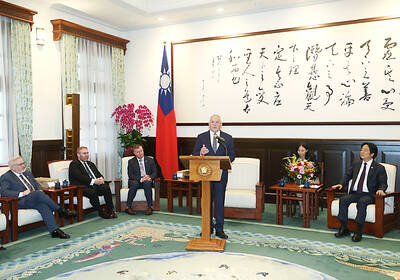The Civil Aviation Administration (CAA) on Monday said that it is investigating China Airlines after one of its flights to Busan, South Korea, on Wednesday last week was reported to have narrowly avoided hitting a hill, the site of a 2002 Air China crash that killed more than 100 people.
Former pilot James Wang (王天傑) said in a live stream on Sunday night that CI186 to Gimhae International Airport failed to turn in time while circling on approach, exceeding the approach zone, passing over the Namhae Expressway and nearly hitting Mount Dotdae, the site of the April 15, 2002, Air China Flight 129 crash that killed 129 of its 166 passengers.
On June 12, CI186 landed on the wrong runway at the same airport, an incident that also gained attention after Wang discussed it on YouTube.

Photo: Screen grab from the Civil Aviation Administration’s Web site
China Airlines denied that last week’s flight almost hit the hill, saying that the flight crew executed a go-around in accordance with protocol after determining that the aircraft did not meet the criteria for a stabilized approach.
“A stabilized approach is a practice encouraged by the CAA to ensure flight safety. The aircraft on Wednesday last week landed safely at Gimhae International Airport on the second approach, which met the criteria for a stabilized approach,” the airline said in a statement.
“We continue to remind and train our flight crew based on the distinct qualities of each airport,” it said.
The CAA said it has asked the flight crew who are commissioned to carry out special assignments at the airline to undergo training after the June 12 incident, adding that they must strictly follow standardized procedures.
“We would investigate this alleged safety incident on Wednesday last week and order China Airlines to review it. The company must reinforce the safety of flight operation, including increasing the training in flight simulators,” it said.
After the June 12 incident, the South Korean Ministry of Land, Infrastructure and Transport said it would investigate China Airlines, while the Transportation Safety Board said it would support it if requested.

Taipei on Thursday held urban resilience air raid drills, with residents in one of the exercises’ three “key verification zones” reporting little to no difference compared with previous years, despite government pledges of stricter enforcement. Formerly known as the Wanan exercise, the air raid drills, which concluded yesterday, are now part of the “Urban Resilience Exercise,” which also incorporates the Minan disaster prevention and rescue exercise. In Taipei, the designated key verification zones — where the government said more stringent measures would be enforced — were Songshan (松山), Zhongshan (中山) and Zhongzheng (中正) districts. Air raid sirens sounded at 1:30pm, signaling the

The number of people who reported a same-sex spouse on their income tax increased 1.5-fold from 2020 to 2023, while the overall proportion of taxpayers reporting a spouse decreased by 4.4 percent from 2014 to 2023, Ministry of Finance data showed yesterday. The number of people reporting a spouse on their income tax trended upward from 2014 to 2019, the Department of Statistics said. However, the number decreased in 2020 and 2021, likely due to a drop in marriages during the COVID-19 pandemic and the income of some households falling below the taxable threshold, it said. The number of spousal tax filings rebounded

A saleswoman, surnamed Chen (陳), earlier this month was handed an 18-month prison term for embezzling more than 2,000 pairs of shoes while working at a department store in Tainan. The Tainan District Court convicted Chen of embezzlement in a ruling on July 7, sentencing her to prison for illegally profiting NT$7.32 million (US$248,929) at the expense of her employer. Chen was also given the opportunity to reach a financial settlement, but she declined. Chen was responsible for the sales counter of Nike shoes at Tainan’s Shinkong Mitsukoshi Zhongshan branch, where she had been employed since October 2019. She had previously worked

‘NON-RED’: Taiwan and Ireland should work together to foster a values-driven, democratic economic system, leveraging their complementary industries, Lai said President William Lai (賴清德) yesterday expressed hopes for closer ties between Taiwan and Ireland, and that both countries could collaborate to create a values-driven, democracy-centered economic system. He made the remarks while meeting with an Irish cross-party parliamentary delegation visiting Taiwan. The delegation, led by John McGuinness, deputy speaker of the Irish house of representatives, known as the Dail, includes Irish lawmakers Malcolm Byrne, Barry Ward, Ken O’Flynn and Teresa Costello. McGuinness, who chairs the Ireland-Taiwan Parliamentary Friendship Association, is a friend of Taiwan, and under his leadership, the association’s influence has grown over the past few years, Lai said. Ireland is